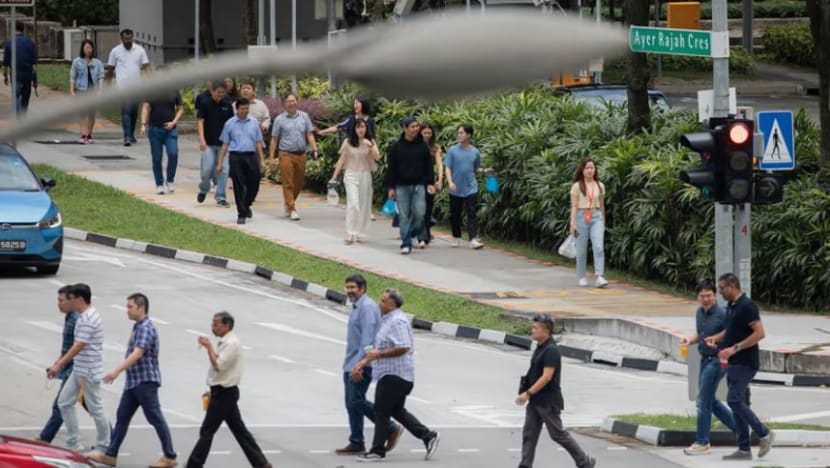Commentary: Singapore has long resisted unemployment benefits, so why the change of heart?
Don’t mistake plans to provide financial support to retrenched workers for a change in philosophy about welfare. It will still be very much in line with Singapore’s ethos of self-reliance, says NUS labour economist Kelvin Seah.

SINGAPORE: Singapore has long resisted the idea of unemployment benefits. A job is the best form of welfare, as the maxim goes.
So when Prime Minister Lee Hsien Loong announced at the National Day Rally that there would be a new scheme to provide temporary financial aid for retrenched workers, there was much chatter. More recently, Deputy Prime Minister Lawrence Wong said that there were plans to introduce this support as part of a revamped SkillsFuture programme.
Over the years, there have been several proposals to introduce unemployment benefits. However, they were rejected by the government because they ran counter to Singapore’s values of self-reliance.
What has changed in the impetus to provide unemployment support?
Mr Wong said that the accelerated pace of economic transformation has prompted a rethink on the support for displaced workers. While Singapore has managed to keep unemployment rates low, technological advancements such as artificial intelligence could easily disrupt businesses and make jobs redundant.
The large number of layoffs in the tech sector last year was possibly a catalyst. It demonstrated how easily people could lose jobs because of technological changes and company reorganisation, factors arguably beyond their control. While workers have historically been displaced by technology, the current wave of change differs in its pace and scale.
Singapore’s move is an attempt to answer a worrying question: Even if a job is the best form of welfare, what happens if more people are forced out of one?
BENEFITS OF UNEMPLOYMENT SUPPORT MAY SURPASS THE COSTS
That Singapore now has plans to introduce financial support to those who are involuntarily displaced suggests that the government anticipates that the benefits will surpass the costs moving forward.
Unemployment benefits have their downsides: They could lower incentives for unemployed workers to find jobs, lead to people deliberately taking a long time to find a job, or even putting in less effort into existing jobs.
Many studies have shown that unemployment benefits affect labour supply. A 2015 study by Nobel Laureate David Card and his colleagues showed that greater unemployment benefits lead to longer durations of unemployment.
Of course, since the financial support comes from public coffers, taxpayers end up bearing the brunt of long-term welfare dependency. Even countries that recognise the need for unemployment benefit reform often find it politically challenging to do so.
That being said, there are benefits from having unemployment support, and these could be large.
It helps workers who are involuntarily displaced meet their immediate financial needs, thereby relieving them of stress and anxiety. People with a family to support and loans to pay will not be forced to sell their assets in a hurry or hastily accept jobs that they are not well-suited for - that skills mismatch could have worse longer-term effects for employers and employees.
And this is perhaps one reason why most developed countries have some form of unemployment support programme.
NO CHANGE IN PHILOSOPHY ABOUT WELFARE
But don’t mistake this for a change in philosophy about welfare. Singapore’s approach will still be very much in line with its traditional ethos of enabling self-reliance.
A departing feature from the unemployment insurance systems typically practised in European countries is likely to lie in the training requirements.
While the details have not been announced, the fact that the unemployment benefits will come under the revamped SkillsFuture scheme suggests that benefits will likely be tied to training or career counselling.
Yet, there are practical issues that need to be resolved. How do we ensure unemployed workers will actively look for a job after training?
While it is easy to monitor whether individuals are undergoing training, it is more challenging to monitor whether they are actively looking for a job. Unless there is active official monitoring of each applicant, it will be important to take steps to minimise perverse incentives.

DISCOURAGE LONG-TERM DEPENDENCY AND GAMING
How can the system be designed so that people will not find it in their interests to game the system?
To discourage people from being on support for too long - idling at home instead of actively looking for a job - there could be a cap on the duration over which benefits are paid. Or the level of support could be tied to duration, starting relatively high in the first few weeks of unemployment before declining with time until it eventually reaches zero at some point.
While many countries do have a limit on the duration over which unemployment benefits are paid, some countries such Australia, surprisingly, do not have such restrictions.
The amount should also not be too large that it encourages people to remain unemployed. One approach might be to consider last drawn salary with an appropriate level of discounting. For example, the level of support could be set at a percentage of last drawn pay, with some maximum cap imposed.
Of course, a balanced approach is needed, and the level of discounting should not be so large that it makes the support effectively useless. The objective should be to provide workers with enough protection so that they have the ability to meet their immediate financial needs during the period of unemployment, but yet create enough urgency for them to find a job.
Mr Wong alluded to the benefits being “appropriately sized”. But people will inherently differ in what they deem to be appropriate.
Will the support be set at some flat amount for fairness? People who are content to earn less than this set amount may inclined to remain unemployed. Alternatively, basing it on last drawn salary would cater to individuals’ unique financial needs - but that would necessarily mean different amounts for different people.
DEVIL IN THE DETAILS
Who exactly qualifies for unemployment support could also be a thorny issue. The scheme is intended to support retrenched workers, which could be interpreted as those involuntarily terminated due to reasons such as company reorganisation.
But in practice, workers may be asked to leave because of a combination of reasons, including company organisation as well as poor work conduct or performance. Should support still be provided in such cases? If not, how do we distinguish workers apart?
Finally, there has been some debate on whether to extend benefits to those who are voluntarily unemployed - perhaps those who anticipate that their industries will soon be in decline and who prefer to proactively seek training to stay competitive rather than wait for retrenchment.
But the new unemployment support mechanism would not be the right platform for such cases since there are already other existing programmes such as Workforce Singapore’s Career Conversion Programmes.
The idea of unemployment support is noble, and if managed well, could be used to increase the well-being of workers. But the devil will be in the details.
Kelvin Seah Kah Cheng is a Senior Lecturer at the Department of Economics, National University of Singapore and a Research Fellow at IZA Institute of Labor Economics.




















